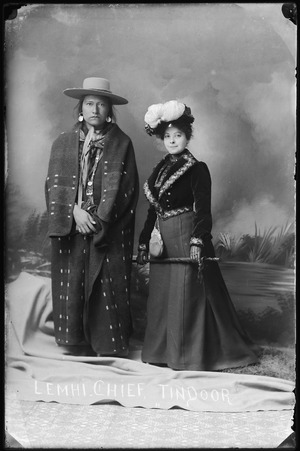Lemhi Reservation facts for kids
The Lemhi Reservation was a special area of land set aside by the United States government for the Lemhi Shoshone people. This reservation existed from 1875 to 1907. For most of this time, their main leader was Chief Tendoy.
The group of about 700 people who lived on the reservation in 1875 included not only the Lemhi Shoshone but also Sheepeater Indians and Bannocks. Chief Tendoy himself had one Lemhi Shoshone parent and one Bannock parent.
On February 12, 1875, President Grant created this 100-square-mile reservation in the Lemhi Valley. It was meant for "the exclusive use of the mixed tribes of Shoshone, Bannock, and Sheapeater Indians." However, almost right away, the government and local people tried to take the land back. They succeeded in 1905. In 1907, the Lemhi people were forced to leave their homes and move to the Fort Hall Indian Reservation. Many called this difficult journey the "Lemhi Trail of Tears."
Contents
The Lemhi Shoshone and Their Land
The Lemhi Shoshone people were forced from their homeland in 1907. They have wanted to return ever since. As the United States remembers the Lewis and Clark Expedition, it's important to think about the Lemhi Shoshone. They played a huge part in helping Lewis and Clark succeed.
Sacagawea's Story and Lewis & Clark
In August 1805, Lewis and Clark and their team reached the Three Forks of the Missouri River. Back in October 1804, they had hired Toussaint Charbonneau and one of his wives, Sacagawea. She was a fifteen-year-old Shoshone woman who was six months pregnant. The expedition needed Charbonneau and Sacagawea for their language skills. He spoke French, and she spoke Hidatsa and Shoshone.
Sacagawea had been captured by a Hidatsa raiding party near the Three Forks four years earlier. She was living at Fort Mandan when Charbonneau won her in a bet. Lewis and Clark knew it was vital to have someone who spoke the language of the tribes in the Rocky Mountains.
When Lewis and Clark reached the Three Forks of the Missouri River, they urgently needed horses from the Shoshones. They also needed to learn about the land to cross into the Columbia River area. Sacagawea was incredibly important. With her help, the expedition met the Shoshones and became friends. They shared food and gifts. They also smoked a pipe with the people led by Cameahweit, who turned out to be Sacagawea's brother.
Soon after, Lewis and Clark realized the Salmon River was too rough for their boats. They talked with Cameahweit about the best way to cross the mountains to the Nez Perce land. Cameahweit gave them a guide named Old Toby. The expedition traded for about thirty horses to carry their supplies over the mountains. With Old Toby's help, the team finally reached the Nez Perce villages in late September 1805. Historian Stephen Ambrose said Sacagawea's people were very important. He explained that "Without Shoshone horses, without Shoshone information, the expedition might as well turn around and go home."
Life of the Lemhi Shoshone People
In 1805, the native people living in the Lemhi and Pahsimeroi valleys and along the Salmon River were two main groups. These were the Agaidika, also known as Salmoneaters, and the Tukukika, or Sheepeaters, who lived in the nearby mountains. These people found food by digging for camas plants, fishing for salmon, and hunting mountain sheep, deer, antelope, and buffalo. This way of life was typical of Plateau Indian culture.
These two groups in the Salmon River Country were an organized tribe. They crossed the Bitterroot Mountains to hunt buffalo north and west of Yellowstone. They also traveled to the Camas Prairie near Nez Perce country. Sometimes, they went north to trade with their friends, the Flatheads. After 1805, perhaps around the 1850s, some Bannock Indians joined the Salmoneaters and Sheepeaters. These Bannock people, about one hundred of them, came north from Fort Hall. They became part of the Lemhi tribe living in the Salmon River country.
The Fort Lemhi Mission
Mormon missionaries were the first non-Native Americans to have a lasting relationship with the Salmon River Indian people. They arrived in the Salmon River Valley in 1855. About twenty-seven Mormon men left the Salt Lake Valley on May 18, 1855. They reached Fort Lemhi on May 27 and chose a permanent spot for their mission on June 15, 1855. The mission, named Fort Lemhi, was about two miles north of where Tendoy, Idaho, is today. The name "Lemhi" came from King Limhi, a king mentioned in the Book of Mormon. In Mormon writings, King Limhi led a trip that lasted twenty-two days. This was the same amount of time it took the Mormon missionaries to reach the Salmon River Country. So, they named their mission after King Limhi, and over time, Limhi became Lemhi.
The Mormon mission had some success. The Lemhi leader, Snag, became a Mormon. His decision led to about 100 Lemhi people being baptized.
However, problems among some Bannocks, Nez Perces, and the mission led to fighting. In February 1858, two hundred Shoshone and Bannock warriors attacked the mission. They killed two missionaries and stole cattle and horses. The mission closed its doors on March 26, 1858.


